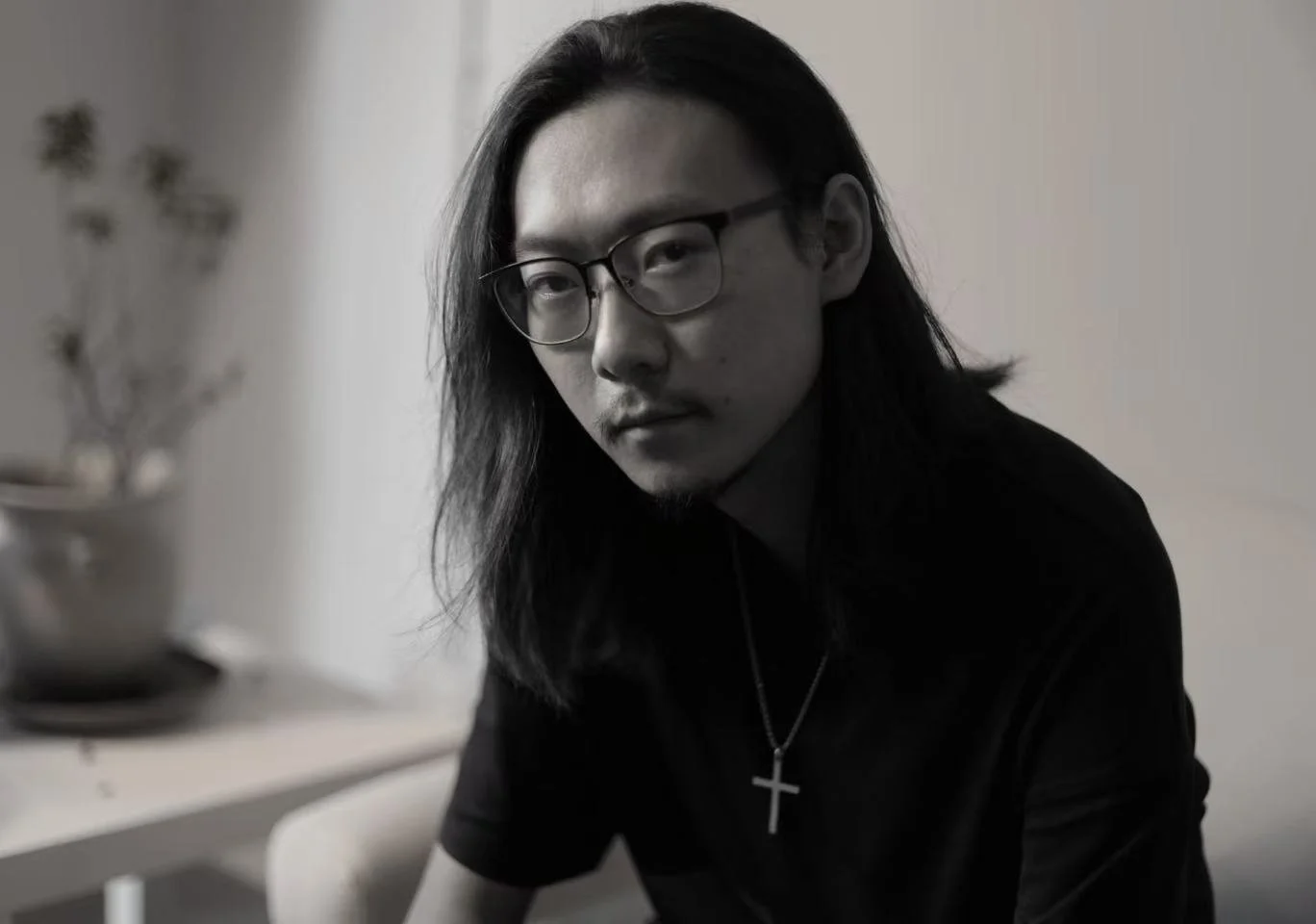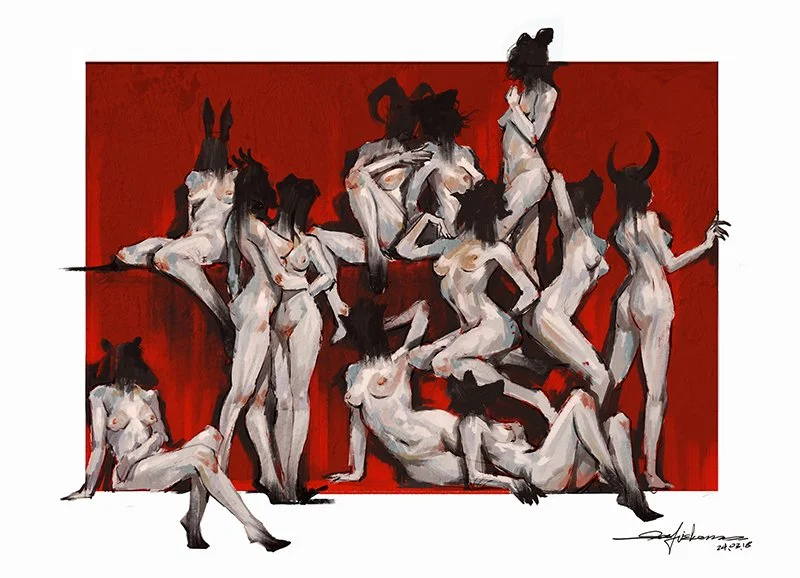10 Questions with Min Kun Li
MinKun Li (Sam Fisher) is a new media creator and art educator active at the forefront of digital art. His creations are based on digital media, completing the deconstruction of art and the contemporary translation of religious culture, and constructing a field with both spiritual and technological characteristics in virtual space.
Min Kun Li - Portrait
The core of his creations continues the philosophical thinking of "Trace the origin to illuminate the present", inheriting the minimalist gene of Malevich's Supremacy, and reconstructing Kandinsky's "inner needs" theory through dynamic digital technology. He transforms religious symbols into cyborg nerves, awakening the digital resonance of the collective unconscious in the dialectic of deconstruction-reconstruction.
The visual of his works presents the aesthetic characteristics of twin juxtaposition: on the one hand, it continues the narrative tradition of Concept Art, and constructs a metaverse picture that combines Eastern metaphysics and science fiction aesthetics with the epic composition of fantasy artist BROM and the dramatic light and shadow of game works; on the other hand, it returns to the purity of abstract art, guiding the audience to complete the digital pilgrimage in the pixel matrix.
In the face of an era of accelerating technology, Sam Fisher continues to explore the essential proposition of digital art - how to preserve the spiritual fire of culture in the flood of data. This is not only an artistic question for digital natives, but also an open answer reserved for the technological era: when civilisation flows continuously in the form of data, art may become one of the ways for us to regain divinity.
The flowers growing in the bones, 2025 © Min Kun Li
INTERVIEW
First of all, could you share your background and what made you engage in digital media work?
I got involved in digital media work because I am a game concept artist. I majored in animation in university. I need to handle a large number of pictures and design content. With the development of my career, I gradually expanded into the field of knowledge dissemination, which naturally drove me to deeply study digital media technology.
How have your studies or experiences shaped your attitude towards art and technology?
Art is great. It can nourish and redeem several moments in life. In my experience of painting, from traditional painting to digital art, whether it is 3D modelling, animation or special effects, it has made me understand that tools are for the service of creators. Advanced technology can shorten the creation time and enable creativity to be better realised.
What inspired you to combine religious symbols with themes of numbers and cybernetics?
When I was looking up materials by chance for inspiration, I found that some old records and materials only had simple pictures and brief textual descriptions. They were not as attractive as modern images. This information gap gave them a lot of room for imagination, so I came up with the idea of using digital media to deconstruct and connect the past and the present.
The dark Graces, 2024 © Min Kun Li
Could you describe your creative process when creating new media works?
I think the process of creation is very interesting. Different artists will choose different media, materials or visual languages. The cost of trial and error and exploring different ideas in new media creation is very low. Many interesting conflicts will arise in this process, but it will also make this process full of challenges and unknowns.
The series of Ars Goetia was first recorded in a book called "Solomon's Little Key". When I looked it up, I saw some very cool Western esoteric content. Many characters would have some changes and differences in different cultures. According to the descriptions and stories of each version, I tried my best to express the abstract descriptions in the book through graphics and design. Meanwhile, I need to balance imagination and the rationality of design.
During this process, I will repeatedly try to overthrow some ideas. It will take me weeks or even months to weigh the content. At the same time, I will also browse a large number of models and works of some excellent creators, hoping to find some commonalities and creative ideas worth learning from them.
Moreover, if it is some abstract or emotional creations, directly choosing objects that conform to the emotional expression is a good option, just as Malevich advocated, allowing the audience to directly engage in dialogue with the work, in which everyone's feelings are different.
Sometimes this kind of creation is based on dreams, like in "The face in the dream, your grievances, our kisses and hugs_2024", sometimes I express the traditional Chinese zodiac in another way. Like "Zodiac_2024", express emotions with colours and combine symbols to form specific meanings. In "The root of all evil_2024", there will be reflections on desire and sex again.
You often mention Malevich and Kandinsky. How do their ideas influence your digital practices?
I can't help but wonder, behind today's inclusive diversity, what kind of artists and martyrs have created today's prosperity? I gradually came to understand that the era was full of changes and innovations, gradually moved by their deeds, and gradually understood the intricate connections between modern design and constructivism, as well as the tremendous contributions made by the German Bauhaus to many fields today. Malevich's suprematism, on the other hand, holds an extraordinary significance in his views on art. It's hard for me to express all of this in words, but I believe it's just the tip of the iceberg. This spirit of tracing back to the source constantly reminds me to keep exploring and making progress without forgetting my original intention. I am both a pilgrim and a preacher.
There is another dark artist I have to mention, BROM. I think he has also had a great influence on me. Usually, oil paintings and digital media are inherently incompatible, but I really enjoy incorporating some of the textures of oil paintings into my works. I also really like the illustrations BROM created for Blizzard, which makes me unconsciously lean towards BROM's dark style when creating the Ars Goetia series.
Zodiac, 2024 © Min Kun Li
Zodiac, 2024 © Min Kun Li
Your works blend Eastern metaphysics and science fiction novels. How do you balance these elements visually and conceptually?
Expressing traditional culture in a brand-new way is indeed a challenge, not to mention integrating these cultural symbols. Both "Zodiac_2024" and the Ars Goetia series are redefining these cultural symbols with digital media. Viewers need to understand the culture represented by these symbols. It is necessary to present a completely different feeling in a brand-new way. This process is always full of surprises and choices. On the premise of clarifying the cultural tone of the work, take advantage of the benefits of digital media to make the work as rich and diverse as possible, and create some themes that have never been seen by the public or have entered the mainstream vision.
In the context of today's digital world, how do you define "the spiritual fire of culture"?
As mentioned above, this is an era of prosperity, but also an era of entertainment to death. A large number of traditional arts are being phased out and impacted by new tools and AI. The "spiritual fire of culture" is more like a kind of belief, using artistic creation that carries unique human emotional experiences and philosophical thoughts to resist technological alienation, enabling us to constantly innovate and explore in art. In the torrent of The Times, it is an unextinguishable spiritual lighthouse and a beacon that can be passed down. Nowadays, not only is fast-paced technology needed, but it is also needed for pure art and personal expression.
What tool or platform do you use most frequently in your digital art creation? Why?
In my creative work, I usually use Photoshop, Procreate, etc. They have powerful image processing capabilities and can meet almost all needs. The completed works are usually released through the Internet in some art communities.
QI_C, 2025 © Min Kun Li
How are your works accepted by audiences and the digital art community?
Usually, my job is directly related to game products. I have to make many plan adjustments for different themes and stories, and use visual images to create common emotions and experience feelings. Apart from social media, I also take part in some related competitions. Competing with the top peers in the industry excites me the most.
Finally, what are you currently doing and what directions do you hope to explore in future projects?
At present, I devote more time to my own creation and study, hoping to have more diverse thematic creations. Meanwhile, I am also training students majoring in related fine arts, including sharing my work experience, project processes and my views on life. In the future, I will continue to create the Ars Goetia series and keep building a better digital art learning and service platform.
Artist’s Talk
Al-Tiba9 Interviews is a promotional platform for artists to articulate their vision and engage them with our diverse readership through a published art dialogue. The artists are interviewed by Mohamed Benhadj, the founder & curator of Al-Tiba9, to highlight their artistic careers and introduce them to the international contemporary art scene across our vast network of museums, galleries, art professionals, art dealers, collectors, and art lovers across the globe.




















